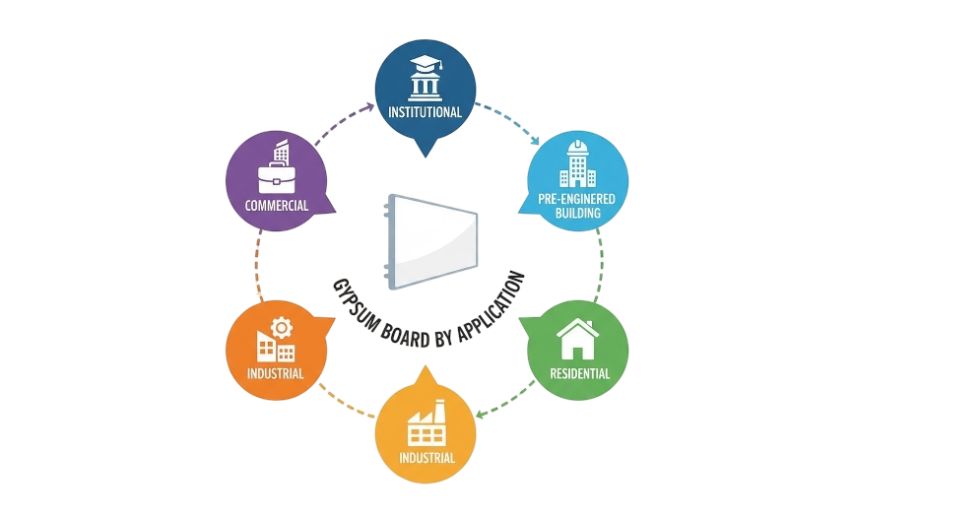
Nov 07, 2025

Interior finishes and partition systems in the modern construction world are no longer mere decorative elements; they have turned into integral parts that dictate how buildings perform, feel and function. The global gypsum board market, as per Metastat Insight, has garnered global attention for its capacity to change dull walls and ceilings into an ensemble of fire safety, sound equilibrium and speedy installation. The rapid urbanization process, which has already been at the forefront of construction, along with tougher building regulations and the need for quick construction, has contributed a great amount to the role of gypsum boards in modern buildings.
Market Context
The construction sector is experiencing a series of severe challenges: labour scarcity, prolonged construction period, higher quality of building demand and environment-friendly practices pressure. Heavy masonry partitions and traditional plaster systems are unable to meet the contemporary requirements of speed and performance. However, gypsum board systems have come up as essential enablers by providing faster installation, uniform finishes, and compatibility with modular construction. These boards assist in overcoming the delays associated with on-site finishing and laying down the same quality in large-scale projects.
How It Works / Why It’s Valuable
Gypsum board is a construction material that consists of a gypsum core surrounded by papers (or other materials) and it is mainly used for interior walls, ceilings and partition systems. The value of gypsum board comes from a variety of beneficial characteristics such as fire resistance, sound insulation, and finishing easiness, and lightweight and compatibility with modern building service.
Gypsum boards compared to plaster-on-site methods have shorter drying times, fewer trades needed, and are more convenient for integrating with wiring and services. In high-rise, commercial, or institutional applications, these boards allow for the use of tiling, painting or cladding with the same quality throughout the building thus the quality of the construction becomes the same. Basically, the material makes construction easier and helps to get the desired interior look.
Growth Story / Technological Evolution
Gypsum board system adoption has moved from a niche in advanced construction markets to a common practice across new buildings and refurbishments. At first, gypsum board was restricted mainly to high-end commercial construction but now even residential, institutional, and industrial settings have it as a standard material. With time, boards have been improved and also newer and better types have been introduced - fire resistance and moisture resistance are enhanced, acoustic separation and larger panel size have become standard. Manufacturing techniques and strong supply chains have also contributed to system availability. As modular and prefabricated construction practices gain acceptance, gypsum board is right there in the supporting role being part of wall systems and mass-produced partitions.
Regional and Global Trends
If we look at it geographically, the vastest adoption is in the regions where urbanisation is happening at a fast pace and there is a lot of new construction going on mainly in the Asia-Pacific area. Just to give a few examples, the overall growth in China, India, and Southeast Asia is the result of massive residential and commercial building projects taking place in those countries.
On the other hand, North America and Europe, which are more mature markets, still consume top-quality gypsum boards mostly for renovation and sustainability reasons. The aforementioned regions the Middle East & Africa and Latin America are also emerging markets with great potential due to the fact that their current demand for partition and ceiling systems is primarily driven by their infrastructure development and improved living conditions.
Challenges and Opportunities
When it comes to challenges, the gypsum board supply chain is still subject to vulnerability fluctuations in raw material prices, transport costs, and regional logistics all contribute to the complexity of the situation. Furthermore, the need for moisture-sensitive environments, storage problems, and competition from other systems (like metal framing, concrete-based panels) might limit the adoption of gypsum boards.
On the other hand, the integration of sustainable building practices (such as the use of recycled gypsum and boards with lower embodied carbon) is a great opportunity for the industry to grow. The upsurge of modular construction, the increase of refurbishing and the growing demand for high-quality finishes in developing markets are all points that highlight strong benefits. Additionally, the merging of interior material systems with acoustic and fire-safety regulations creates new ground for developing value-added products.
Why It Matters Now
With global construction activity under pressure to deliver faster, safer and greener buildings, the global gypsum board market as delineated by Metastat Insight takes on elevated importance. It is positioned not just as a finish material, but as a construct-efficiency tool, a code-compliance enabler and a sustainability lever in the built environment. In a time when building performance matters as much as form, this market segment is shaping how interior spaces are created and upgraded and will influence both the speed and sustainability of the built world going forward.
Drop us an email at:
Call us on:
+1 214 613 5758
+91 73850 57479